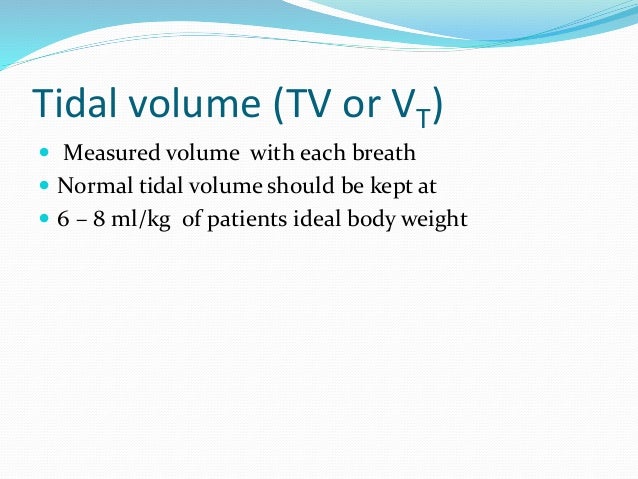

119 As a result, low minute ventilation (lower than normal tidal volume and respiratory rate) can maintain effective oxygenation and ventilation during CPR. The normal tidal volume is 6 to 8 ml/kg, regardless of age. During CPR cardiac output is &25 to 33 of normal, 118 so oxygen uptake from the lungs and CO 2 delivery to the lungs are also reduced. Tidal volume is the volume of gas that is moved in and out of the lungs per breath.

This has the effect of taking more oxygen into the body and removing more carbon dioxide. The Surviving Sepsis guidelines endorse low-tidal-volume ventilation (6 ml per kilogram of predicted body weight). Minute ventilation = breathing rate × tidal volumeĭuring exercise, tidal volume increases as does the depth of breathing and the rate of breathing. The average minute ventilation is 6 litres per minute. Minute ventilation (VE) is the total volume of air entering the lungs in a minute. The average tidal volume is 0.5 litres (500 ml). Tidal volume (TV) is the amount of air breathed in with each normal breath. The average breathing rate is 12 breaths per minute.
NORMAL TIDAL VOLUME PER KILOGRAM PLUS
For females, it is 45.5 plus 2.3, times the product of height in inches. At high flows of 2 litres per kilogram per minute, using appropriate nasal prongs, a positive distending pressure may be achieved. For males, the formula is 50 plus 2.3, times the product of height in inches minus 60. Calculate the ideal body weight using the Devine Formula 1. Taking part in regular aerobic exercise has been shown to increase a person's vital capacity.īreathing rate (frequency, BR) is the number of breaths in a minute. Most people do not have access to this equipment but can estimate the tidal volume by using the patients body dimensions. (a) Write a function representing the tidal volume T 6) (in mL) of a mammal of mass 2 (in kg) (6) Write an equation for 7'() (e) Find ' (176) and interpret its meaning in context. Set the pressure-support ventilation (PSV), if required. Set the high-pressure alarm per the organization’s practice above the child’s PIP to protect the lungs from sudden changes in resistance or compliance. Tidal volume typically measures around 500 milliliters (mL) for those assigned male at birth and 400 mL for those assigned female. Tidal volume (Vt or TV) is the amount of air you move through your lungs each time you inhale and exhale while youre at rest. Vital capacity is the maximum amount of air that can be breathed out after breathing in as much air as possible. Question: Suppose that during normal respiration, the volume of air inhaled per breath (called 'tidal volume') by a mammal of any size is 5.57 mi. In the volume-controlled mode, the child’s lung compliance may cause variable PIP. The Amount of Air Moved In and Out While Breathing. The average breathing rate is 12 breaths per minute.


 0 kommentar(er)
0 kommentar(er)
